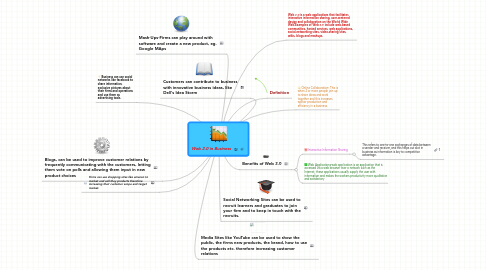Web 2.0 in Business
da Tshepo Motang'


1. Business can use social networks like facebook to share information, exclusive pictures about their firms and operations and use them as advertising tools.
2. Firms can use shopping sites like amazon to market and sell they products therefore increasing their customer scope and target market.
3. Customers can contribute to business with innovative business ideas, like Dell's Idea Storm
4. Media Sites like YouTube can be used to show the public, the firms new products, the brand, how to use the products etc. therefore increasing customer relations
5. Blogs, can be used to improve customer relations by frequently communicating with the customers, letting them vote on polls and allowing them input in new product choices
6. Mash-Ups-Firms can play around with software and create a new product, eg. Google MAps
7. Online Collaboration- This is when 2 or more people join up to share ideas and work together and this increases worker production and efficiency in a business.
8. Web 2.0 is a web applications that facilitates interactive information sharing, user-centered design and collaboration on the World Wide Web.Examples of Web 2.0 include web-based communities, hosted services, web applications, social-networking sites, video-sharing sites, wikis, blogs and mashups.
9. Definition
10. Benefits of Web 2.0
10.1. Interactive Information Sharing
10.1.1. This refers to one-to-one exchanges of data between a sender and receiver, and this helps out alot in business as information is key to competitive advantage.
